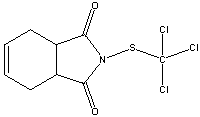
NTP Study Reports

NTP Study Reports
Home » Study Results & Research Projects » NTP Study Reports » All Long-Term Reports » Abstract for TR-15 - Captan

Captan is a broad-spectrum fungicide which inhibits mycelial growth from germinating fungus spores. As a result, it has effective protection action, although it will not eradicate a preexisting infection. Because captan is a nonpersistent fungicide, directions for use indicate that it should be reapplied every week as necessary to maintain control. It has been one of the most widely used fungicides since its introduction in 1950.
A bioassay of technical-grade captan for possible carcinogenicity was conducted by administering the test material in feed to Osborne-Mendel rats and B6C3F1 mice.
Groups of 50 rats of each sex were administered one of two doses of captan for 80 weeks, then observed for 33 or 34 weeks. The time-weighted average doses for both sexes of rats were 2,525 or 6,050 ppm. Matched controls consisted of groups of 10 untreated rats of each sex; pooled controls, used for statistical evaluation, consisted of the matched controls combined with 75 untreated male and 75 untreated female rats from similar bioassays of six other test chemicals. All surviving rats were killed at 113-114 weeks.
Groups of 50 mice of each sex were administered the test material at one of two doses, either 8,000 or 16,000 ppm, for 80 weeks, then observed for 11 weeks. Matched controls consisted of groups of 10 untreated mice of each sex; pooled controls, used for statistical evaluation, consisted of the matched controls combined with 80 untreated male and 80 untreated female mice from similar bioassays of six other test chemicals. All surviving mice were killed at 90-91 weeks.
The mean body weights of both low- and high-dose rats and high-dose mice were lower than those of the matched controls throughout most of the study. Mortality rates did not show statistically significant dose-related trends in either sex of either species.
In rats, a positive dose-related trend and a difference between incidences of tumors in high-dose and pooled-control groups were found in females when the data for adrenal cortical adenoma were combined with those for adrenal cortical carcinoma (pooled controls, 0/64, low-dose 2/50, high-dose 3/47, P=0.047). There was also a positive dose-related trend for the incidence of C-cell adenoma of the thyroid in female rats (pooled controls 1/66, low-dose 1/49, high-dose 4/44, P=0.035). These endocrine tumors in female rats are believed to have been spontaneous, and not related to treatment.
In mice, the incidences of polypoid carcinoma (adenocarcinoma in adenomatous polyp) of the duodenum were statistically significant using tests for a positive dose-related trend both in male mice (pooled controls 0/68, low-dose 1/43, high-dose 3/46, P=0.033) and in female mice (pooled controls 0/68, low-dose 0/49, high-dose 3/48, P=0.022). When the incidences of adenomatous polyp, NOS (not otherwise specified), were combined with those of polypoid carcinoma for statistical analysis, the tests for male mice indicated a substantial increase in significance (pooled controls 0/68, low-dose 3/43, high-dose 5/46, P=0.008).
It is concluded that under the conditions of this bioassay, tumors in the duodenum of B6C3F1 mice were associated with treatment with captan, but there was no convincing evidence that the tumors observed in Osborne-Mendel rats were related to treatment.
Synonym: N-((trichloromethyl)thio)-4-cyclohexene-1,2-dicarboximide
Levels of Evidence of Carcinogenicity:
Male Rats: Negative
Female Rats: Negative
Male Mice: Positive
Female Mice: Positive
Report Date: 1977
Target Organs from 2-year Studies
You may link to the full technical report in pdf format ( Note: A print ready copy of the document is presented in Portable Document Format (pdf) which requires the Acrobat Reader plug-in -- download a free copy of the reader.)
Web page last updated on October 15, 2007
The National Institute of Environmental Health Sciences is one of the National Institutes of Health within the U.S. Department of Health and Human Services. The National Toxicology Program is headquartered on the NIEHS campus in Research Triangle Park, NC.